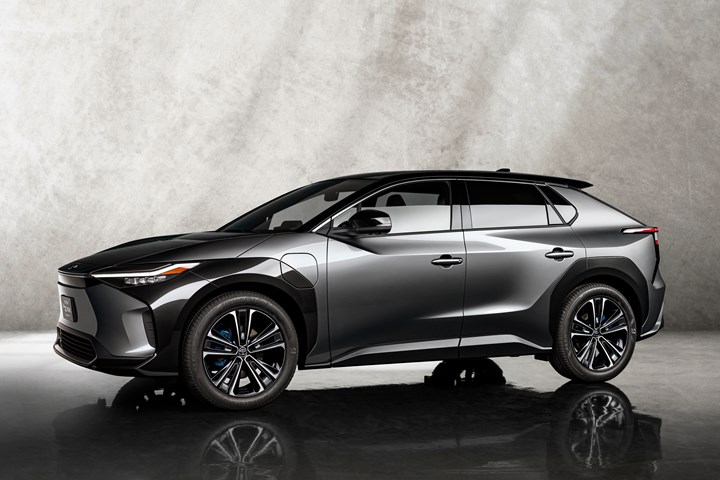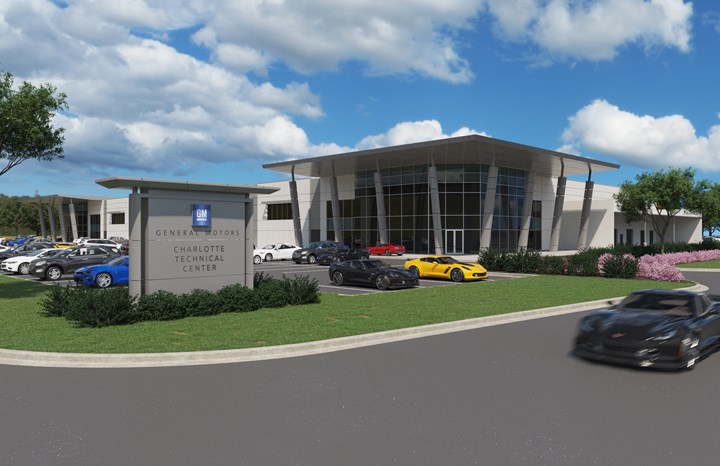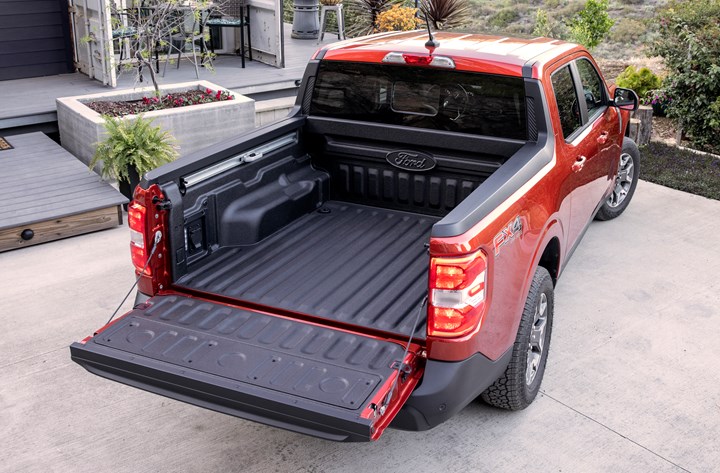On Automotive: Signs of the Times
A close look at Toyota in a period of industry-wide transformation, what will drive on the Moon, calculate your carbon footprint, a look at the Ford Maverick and more
From a deep-dive about Toyota to a look at the platform for the new Ford Maverick and a whole lot more issues and innovations.
This week On Automotive
- Toyota’s Progress & Plans
- Roving on the Moon
- Greenhouse Gases & Your EV
- Remanufacturing Comes to EVs—Already
- A Sign Things Are Good at GM
- A Sign The Types of Suppliers Are Changing
- Ford Maverick: What Came First, the Platform or the Bed?
///
Toyota’s Progress & Plans

The Toyota bZ4X SUV Concept will become a production vehicle in 2022. This battery electric crossover, about the size of a RAV4, was developed along with Subaru. It is based on a new EV-dedicated platform (i.e., not a platform that would ordinarily have an internal combustion engine modified for EV use), the e-TNGA. (Image: Toyota)
Maybe it is because he is essentially a sales guy, to hear Bob Carter put it, the auto industry, as it emerges from the year+ pandemic that has caused everything from shutdowns and lockdowns, hospitalizations* and more than a half million deaths, is in not only good shape, but in his words, “This is the best time the industry has ever seen.”
Focusing on the company where he is the executive vice president of Sales, Toyota Motors North America (TMNA), Carter says the company is undergoing a “once-in-a-lifetime transformation” as people within the company are developing “innovation after innovation” and working not only within their four walls (and it should be noted that many of them have literally been and are working within their personal space, as even at TMNA HQ in Plano, Texas, the staff is largely working not there*), but collaborating with others from other companies.
Sales & Semiconductors
Getting back to Carter’s enthusiastic view of the industry, he says that consumers are buying product “at a rate no one in the industry has seen.”
Still, the global semiconductor shortage is having an impact on the product that Toyota produces, as is the case with other OEMs. But according to Jack Hollis, senior vice president, Automotive Operations Group, TMNA, what makes the case at Toyota different is that while it has about 15% of the overall market, the semiconductor shortage has had but 5% of the impact on the company.
JIT & TPS
A question that arises in the context of the semiconductor shortage is whether this might cause a rethinking of the Toyota just-in-time manufacturing approach. David Christ, group vice president and general manager of Toyota Div. says that JIT is “a core tenet of how we manufacture” and that he “doesn’t see that changing.” What may change, he admits, is the level of safety stock that the company may have on hand.
The Toyota Production System has been around for about 70 years. It, too, is subject to kaizen.
Electric & Electrified
Toyota, on a global, not just North American, basis is committed, Ted Ogawa, president and CEO of TMNA, to being carbon neutral by 2050. This means product and process.
On the product side of the ledger, while some auto companies are aggressively promoting how they’re going to become substantially electric in the not-too-distant future, Toyota has been seen as being somewhat more conservative in its approach. Hollis says that the company will have 15% of its offering battery electric (BEV) or fuel cell electric vehicles (FCEVs) by 2030.
Realize that the company that essentially changed the industry in some measure with the launch of the Prius in the U.S. market in 2000 (it was launched in Japan in 1997) has long been at the forefront of “electrified” vehicles (Lisa Materazzo, group vice president, Toyota Division Marketing, says Toyota has been the number-one manufacturer of alternative powertrains for 21 years in a row).
Carter says that by 2030, 70% of the vehicles Toyota and Lexus sell in the U.S. will be “electrified” vehicles (this number includes the full battery-electric and fuel cell vehicles). On a global basis Toyota is anticipating the sale of eight million electrified vehicles, 25% of which will be BEVs or FCEVs.
The Customer Before the Company
Still, there can be the question of why Toyota isn’t going bigger when it comes to full electric vehicles.
And the answer from Cooper Ericksen, group vice president, Product Planning and Strategy, TMNA, is one that may come to haunt other OEMs: “Some companies build a portfolio that they want consumers to buy. We build a portfolio that customers want.”
*Chris Reynolds, executive vice president, Corporate Resources, notes that some 35,000 Toyota employees have been continuing to get the job done in the North American factories where they work turning out Toyota and Lexus products.
///
Roving on the Moon

Apollo 15 astronaut Jim Irwin on the Moon with the Lunar Module and the first Lunar Roving Vehicle on the Moon, August 1971. (Image: NASA)
The first Lunar Roving Vehicle (LRV) landed on the Moon, courtesy of Apollo 15, on August 7, 1971. Astronauts took three trips in the vehicle that was developed, designed and built by NASA’s Marshall Space Flight Center.
Apollo 17 was the last manned mission to the Moon. That took place in December 1972.
In February 2020 NASA put out two Requests for Information (RFI).
- One was for “robotic mobility systems.”
- One was for “human-class lunar rovers.”
Both are for the Artemis lunar exploration program.
Artemis III is planned to land on the Moon in 2024. (Artemis I will be unmanned; Artemis II will be manned but not land.)
As you may know, Lockheed Martin and General Motors have announced they are collaborating on the development of a rover for Artemis.
Who’s In the Driver’s Seat?
What you may not know is that although this is a vehicle, the lead is not General Motors but aerospace company Lockheed Martin.
A Lockheed Martin spokesperson told on Automotive: “For us, GM was a clear choice in our minds. Starting with their legacy of developing the first Apollo rovers and power systems. But more importantly, the battery power research and technologies and the vehicle autonomy are unmatched. When we line up our two companies’ strengths, they align very well. We’re very excited about working with GM on this project.”
///
Greenhouse Gases & Your EV
People buy battery electric vehicles (BEVs) for a variety of reasons. One is environmental.
But how do you know the amount of greenhouse gases (GHG) that are being emitted by your current or potential BEV—calculated all the way down to your ZIP code?
The U.S. Department of Energy has developed an on-line tool that lets you do that, simply and easily.
It’s called the “Beyond Tailpipe Emissions Calculator.”
You can find it here.
But be warned: You may spend a whole lot of time going down the BEV-GHG rabbit hole.
///
Remanufacturing Comes to EVs—Already
At a dealership in Oklahoma City in 1938 four guys started reconditioning engines and other components. It was the Fred Jones Manufacturing Company.
As time went on the company expanded—hugely, globally—and did work for Ford, GM, Honda and other companies. It was renamed ATC Drivetrain.
ATC has announced that it is going into electric vehicle remanufacturing at its facilities in Oklahoma City and Zhanjiang, China.
One & Only
Greg Heald, ATC president and CEO, said, “With our launch of these competencies”—as in remanufacturing batteries and electric drive units for both plug-in hybrids and full EVs—“in the U.S. and China, we expect to be the first and only independent remanufacturer with global capacities for ICE, hybrid and full electric vehicle solutions.”
Know This
But he made another remark that is worth keeping in mind: “Although electrification in vehicles is gaining momentum, it’s important to remember there are still more than a billion internal combustion engine-powered vehicles in the world and their lifespan continues to increase.”
Yes, a lot of ICEs still out there.
///
A Sign Things Are Good at GM

Racing is serious business. GM’s Charlotte Technical Center. (Image: GM)
$45-million.
That’s the amount of money GM is investing in Concord, North Carolina.
For a 130,00-square foot facility.
When open early next year it will include three state-of-the-art driver-in-the-loop simulators, aero development tools, vehicle modeling technology, and more. It will have the ability to “process, analyze and leverage vast amounts of data.”
And the Charlotte Technical Center is focused on racing.
When GM broke ground on the site last week it was joined by some of its neighbors:
- Chip Ganassi Racing
- Richard Childress Racing
- Hendrick Motorsports
Jim Danahy, GM vice president of Global Safety, Systems and Integration, said, “The new Charlotte Technical Center will expand GM’s engineering footprint in the epicenter of racing in the United States and will improve our engineering speed and capability in both the racing and production environments.”
Get the feeling that the “and production environments” is tacked on as a means to help justify the spend?
///
A Sign The Types of Suppliers Are Changing
“The anticipated rebound in vehicle sales following the pandemic will influence demand and order volatility. Improved visibility of market conditions and their effects on production volumes and capacity will give auto suppliers a better understanding about the cost of a business opportunity.”--Bill Foy, Director of Automotive, AWS.
Yes, that is “Amazon Web Services.”
Amazon in auto, providing supply chain visibility.
(Foy’s comment is in relation to AWS working with Campfire Interactive for a system that provides up-to-date dashboards for operational decision making.)
///
Ford Maverick: What Came First, the Platform or the Bed?

The business end of the 2022 Ford Maverick hybrid compact pickup truck. (Image: Ford)
The all-new 2022 Ford Maverick is a unibody, five passenger, four-door pickup—a compact truck with an overall length of 199.7 inches.
It has a 4.5-foot bed on the back with a 1,500-pound payload capacity.
The Maverick is based on Ford’s C2 platform, which is also the base architecture for the Ford Escape.* (Both models are built at the Hermosillo Assembly Plant in Sonora, Mexico. Says Maverick chief engineer Chris Mazur, “This helps with scale efficiencies.”)
So given that they knew what the platform would be, did they size the box on Maverick based solely on that?
Not exactly.
Klaus Palo de Mello, Maverick vehicle engineering manager, points out that even though the platforms are the same, the length of the Escape isn’t nearly that of the Maverick: 180.5 inches.
Obviously there is platform flexibility.
So what about the box?
It is proportionate to the other trucks in the lineup, de Mello says.
That is, the F-150 has a 5.5-foot box. The Ranger has a 5-foot box. So the Maverick’s is 4.5-foot.
Another Similarity in the Back
The Maverick is available as a hybrid, with a 2.5-liter Atkinson-cycle four combined with a Ford-designed and manufactured electric traction motor. The total system horsepower for the standard powertrain is 191. (For those who want more power—as in the ability to have double the towing capability, to 4,000 pounds, there is a 250-hp 2.0-liter EcoBoost.)
The F-150 is optionally available with a hybrid system. This one, of course, more powerful, combining a 3.5-liter EcoBoost six with a 47-hp electric motor, for a total system horsepower of 430.
Both vehicles offer power in the back to operate equipment.
What’s more, on the tailgates of each there are tiedown clamps—that also function as bottle openers.
*(The Bronco Sport is also on the same platform and is built at the same plant.)
RELATED CONTENT
-
The U.S. Military Finds New Roads: Fuel Cell Powered Pickups
While it seems that fuel efficiency as related to the U.S. federal government is all about light duty vehicles, that’s far from being the case.
-
Mustangs, Camaros and F-150s
If you’re shopping for a Mustang, you’re faced with a variety of choices, not simply in terms of the color or the wheels that you’re going to be applying to your ride, but in terms of which model you’re going to select.
-
on lots of electric trucks. . .Grand Highlander. . .atomically analyzing additive. . .geometric designs. . .Dodge Hornet. . .
EVs slowdown. . .Ram’s latest in electricity. . .the Grand Highlander is. . .additive at the atomic level. . .advanced—and retro—designs. . .the Dodge Hornet. . .Rimac in reverse. . .


.jpg;width=70;height=70;mode=crop)






